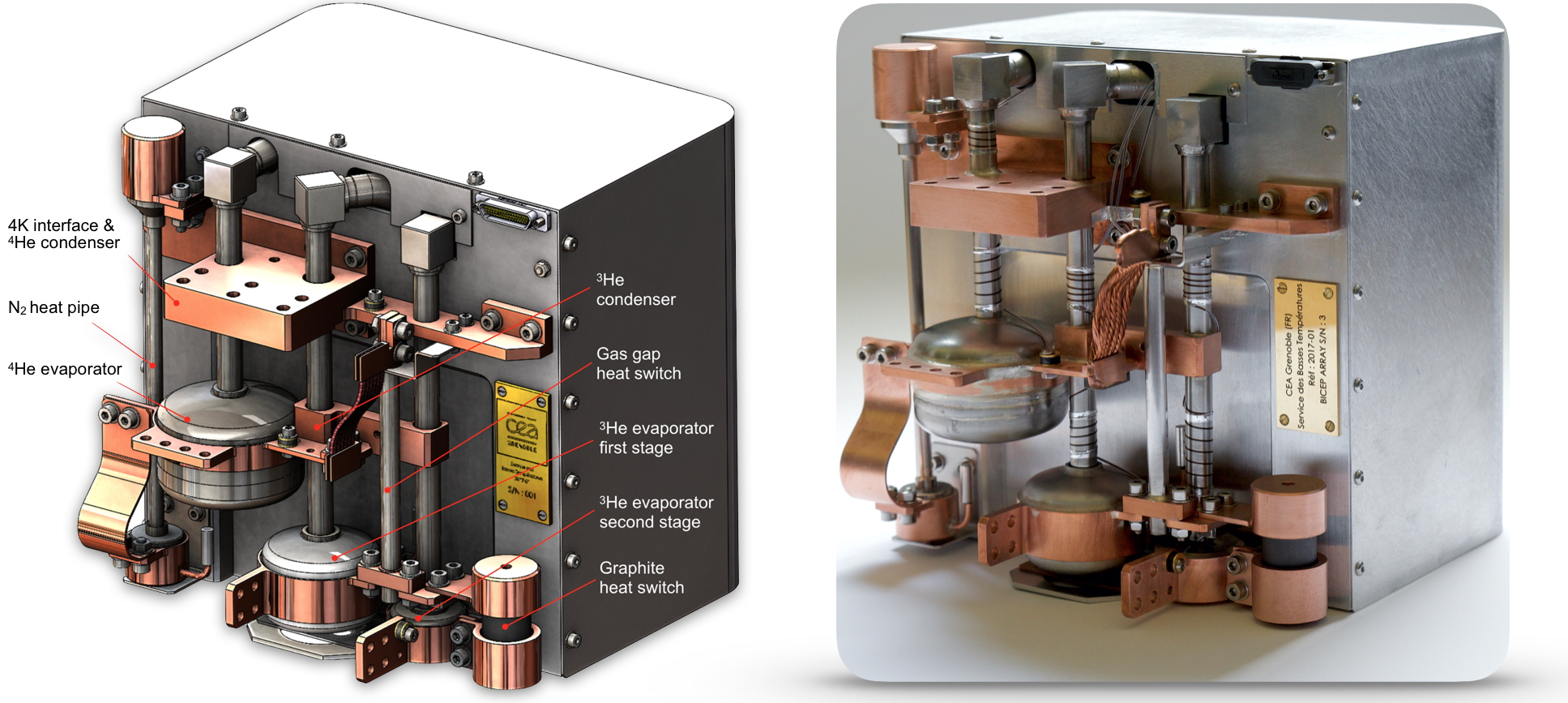The quest for knowledge and the ambition to solve the mysteries around us entail to develop instruments at the state-of-the-art in many technological domains. This is particularly true in astrophysics, where the signals from faint galaxies and other dim sources require to use extremely sensitive devices. In that respect, cryogenics and the use of detectors operating at low temperatures are often essential for the accomplishment of the scientific objectives, offering unmatched performance. There is thus a growing demand for coolers capable of providing temperatures below 1 K.
The Cosmic Microwave Background (CMB) is a fossil radiation emitted 380,000 years after the Big Bang, at the time of recombination, when the Universe became transparent to light. It is an almost perfect uniform black body at 2.7 K, with a temperature anisotropy of about 0.1 mK and a polarization on the order of microkelvin, for an angular scale of one degree. Its observation, and in particular the search for gravitational waves, involves numerous teams around the world. Indeed, the temperature anisotropy and polarization of the CMB are strong signatures for understanding the early Universe. Cosmologists believe that the Universe experienced a rapid period of cosmic inflation during its first fraction of a second, exponentially expanding from a warm and dense subatomic volume. Numerous inflation models predict that this rapid acceleration would have generated gravitational waves that would remained sufficiently energetic 380,000 years later to leave an imprint on the CMB. It is precisely this imprint that the
BICEP Array project is searching for.
For many years, Low Temperature Systems Department (D-SBT) at our institute has been collaborating on this topic with
Caltech and
JPL NASA, supplying around ten sub-kelvin cryocoolers for a number of their different projects. D-SBT holds a significant experience in the development of this type of coolers, particularly for remote and harsh environments, where the reliability constraint is crucial. For this new
BICEP Array project, DSBT has developed a series of 5 three-stage sub-kelvin cryocoolers allowing to cooldown detectors at temperatures below 300 mK (Photo). This system uses adsorption pumps and an evaporative cooling process based on helium 4 and helium 3, to provide cooling at 220, 280 mK and 1.2 K. Besides the detectors, these cold interfaces are used to intercept parasitic loads, cool filters and magnetic shields. This self-contained unit is the last stage of the cryogenic chain consisting in its upper part of a two-stage low-frequency pulse tube delivering cooling capacity at temperatures of approximately 45 and 4 K.
A particular challenge for this project was the large mass to be cooled (26 kg at T < 300 mK) and thus the objective to reduce the associated cooling times. Various active and passive links have thus been integrated into the cooler to limit them. On-site testing will confirm the validity of the proposed options.
The first of these coolers has already been deployed at the Amundsen-Scott base in Antarctica, where it is currently being tested. Three others, also delivered, will follow. The last machine, scheduled to be shipped in the coming weeks, will remain at Caltech in California to serve as a test bed.

Sub-kelvin three-stage refrigerator of the BICEP Array project.
BICEP Array is a project led by multiple partners mainly located in North America (Harvard, Stanford, Jet Propulsion Laboratory (JPL NASA), California Institute of Technology (Caltech), NIST, Toronto, etc.).